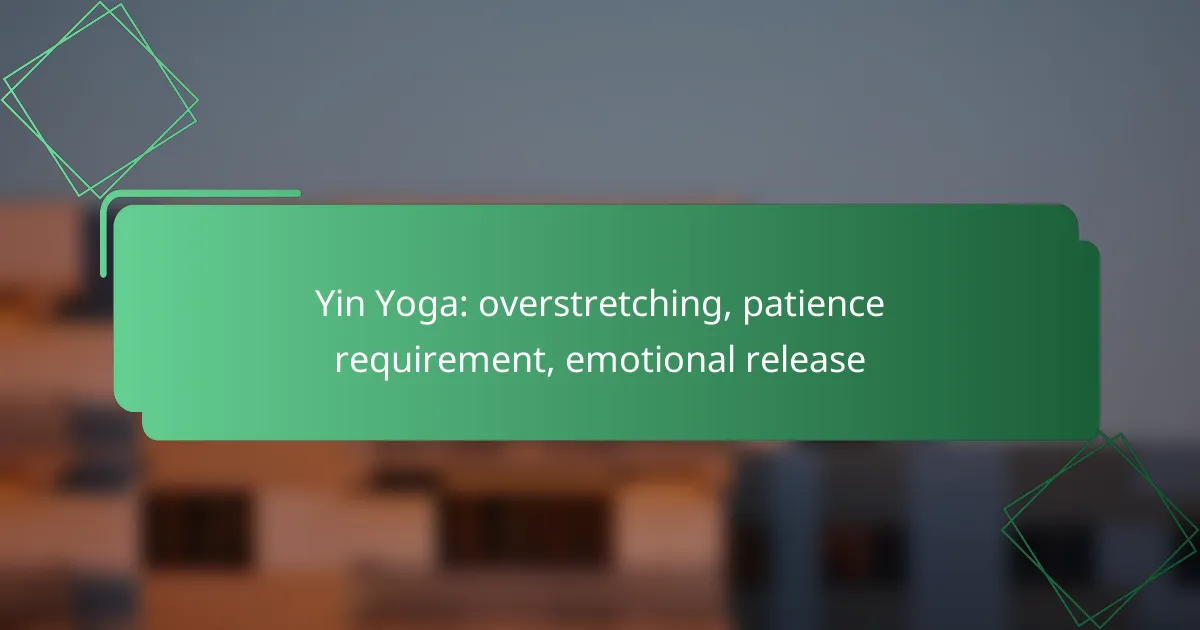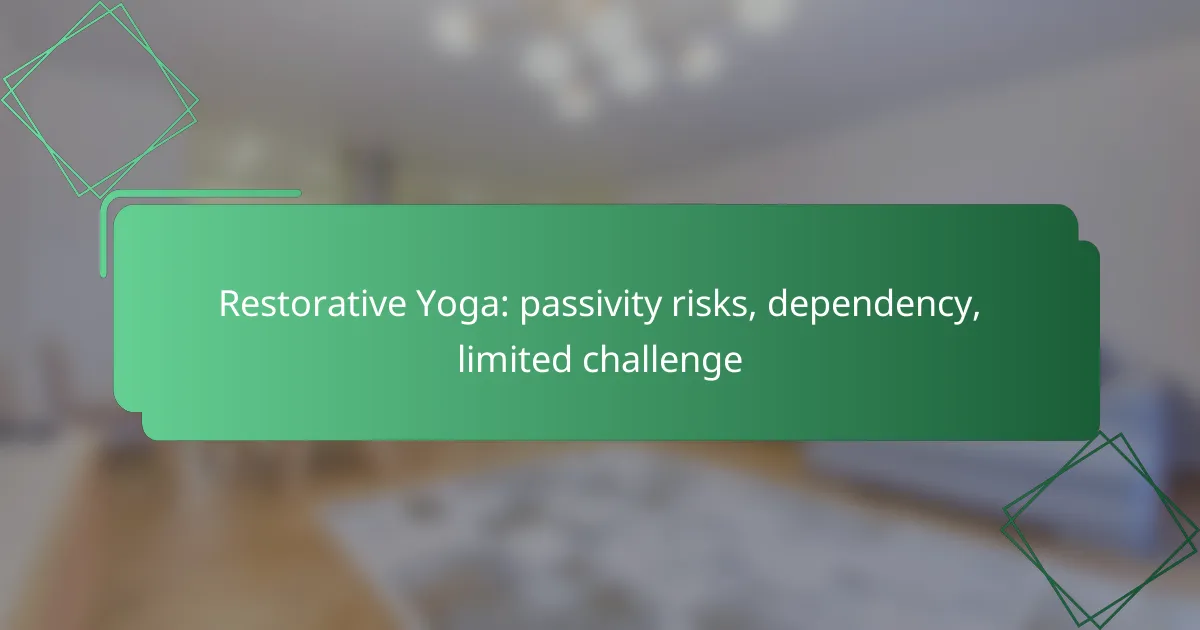Iyengar Yoga emphasizes the use of props to enhance practice, but improper use can lead to injury and hinder progress. While alignment is crucial for safety, an over-reliance on it may prevent practitioners from tuning into their body’s natural cues. To minimize injury risk, it’s essential to engage in proper warm-ups, listen to one’s body, and seek guidance from certified instructors.

How to avoid prop misuse in Iyengar Yoga?
Avoiding prop misuse in Iyengar Yoga involves understanding their intended purpose and using them to enhance your practice rather than hinder it. Proper education on how to utilize props effectively can prevent injuries and promote better alignment during poses.
Proper prop usage techniques
To use props correctly, start by ensuring they are suited to your body type and the specific pose. For instance, when using blocks, place them at the appropriate height to support your hands or feet without compromising your alignment. Adjust the prop’s position as needed throughout your practice to maintain comfort and stability.
Incorporate props gradually into your routine, allowing your body to adapt. For example, if you are new to using a strap, start with basic stretches before advancing to more complex poses. This gradual approach helps build confidence and awareness in your practice.
Common mistakes to avoid
A frequent mistake is relying too heavily on props, which can lead to a false sense of security. While props are beneficial, they should not replace the strength and flexibility your body can develop over time. Avoid using props that are too high or low, as this can disrupt your alignment and increase the risk of injury.
Another common error is neglecting to adjust props during transitions between poses. Always reassess the need for props as you move through your practice, ensuring they continue to support your alignment and comfort. Failing to do so can lead to strain and discomfort.
Benefits of correct prop application
Using props correctly can enhance your Iyengar Yoga practice by improving your alignment and stability in poses. This leads to a deeper understanding of body mechanics and can help you achieve greater flexibility and strength over time.
Additionally, proper prop application can reduce the risk of injury by allowing you to perform poses safely and effectively. For example, using a bolster for restorative poses can help alleviate tension and promote relaxation, making your practice more enjoyable and beneficial.

What are the risks of over-reliance on alignment?
Over-reliance on alignment in Iyengar Yoga can lead to injuries and hinder the natural flow of movement. While alignment is essential for safety, focusing too rigidly on it may cause practitioners to ignore their body’s intuitive signals, resulting in strain or discomfort.
Potential injuries from misalignment
Misalignment can lead to various injuries, particularly in the joints and muscles. Common issues include strains, sprains, and chronic pain in areas like the lower back, knees, and shoulders. Practitioners should be aware that forcing alignment can exacerbate existing conditions or create new injuries.
For instance, if a student excessively tries to align their hips in a pose, they might overextend their knees, leading to potential ligament damage. It’s crucial to listen to the body and adjust poses accordingly to prevent these risks.
Signs of over-correction
Over-correction often manifests as discomfort or pain during practice. If a practitioner feels tension in areas that should be relaxed, or if they struggle to maintain a pose without excessive effort, these may be signs of over-correction. Additionally, if a student frequently adjusts their position based on external cues rather than internal sensations, they might be overly focused on alignment.
Common indicators include muscle fatigue that feels unnatural or a sense of frustration with poses that should feel stable. Practitioners should regularly check in with their bodies to ensure they are not sacrificing comfort for the sake of perfect alignment.
Balancing alignment and intuition
Finding a balance between alignment and intuition is key to a safe and effective practice. Practitioners should aim to understand the principles of alignment while also tuning into their body’s needs. This means allowing for slight variations in poses that accommodate individual anatomy and comfort levels.
One practical approach is to set aside time during practice to explore poses without the pressure of perfect alignment. This can help develop a deeper awareness of how the body feels in different positions, fostering a more intuitive practice. Remember, yoga is not just about alignment; it’s also about connecting with oneself and cultivating awareness.

How to minimize injury risk in Iyengar Yoga?
To minimize injury risk in Iyengar Yoga, practitioners should focus on proper warm-up routines, listen to their bodies, and consult with certified instructors. These strategies help ensure safe practice and enhance overall well-being.
Warm-up routines to prevent injuries
Incorporating effective warm-up routines is crucial for injury prevention in Iyengar Yoga. Start with gentle stretches and movements that gradually increase your heart rate and warm up your muscles. Aim for a warm-up session lasting around 10-15 minutes, focusing on areas commonly engaged during practice, such as the hips, shoulders, and spine.
Consider including poses like Cat-Cow, Downward Dog, and gentle twists to prepare your body. These movements enhance flexibility and circulation, reducing the risk of strains or sprains during more intense postures.
Listening to your body
Listening to your body is essential in minimizing injury risk during Iyengar Yoga. Pay attention to any discomfort or pain, and modify or skip poses that feel unsafe. Practicing mindfulness can help you recognize your physical limits and avoid pushing yourself too hard.
Use a simple scale to gauge your comfort level: if a pose feels more than mildly uncomfortable, it’s a sign to adjust your alignment or take a break. Remember, yoga is about personal growth, not competition.
Consulting with certified instructors
Consulting with certified instructors can significantly reduce injury risk in Iyengar Yoga. Experienced teachers can provide personalized guidance on alignment, technique, and the appropriate use of props. They can help you understand how to safely navigate challenging poses and avoid common pitfalls.
Consider attending classes led by certified Iyengar Yoga instructors who have undergone rigorous training. Their expertise ensures that you receive accurate feedback and support tailored to your individual needs, enhancing both safety and effectiveness in your practice.

What are the prerequisites for safe practice?
Safe practice in Iyengar Yoga requires an understanding of personal limitations and a solid foundation in basic poses. Recognizing your own physical capabilities and limitations helps prevent injuries and enhances the overall experience.
Understanding personal limitations
Each individual has unique physical capabilities that can affect their practice of Iyengar Yoga. It’s crucial to assess your own strength, flexibility, and any pre-existing conditions before engaging in advanced poses. Listening to your body and recognizing when to modify or skip certain postures is essential for avoiding injury.
Common pitfalls include pushing too hard to achieve a pose or relying too heavily on props without understanding their purpose. Practitioners should regularly evaluate their comfort levels and seek guidance from experienced instructors when unsure about their limits.
Importance of foundational poses
Foundational poses serve as the building blocks for more complex postures in Iyengar Yoga. Mastering these basic positions ensures proper alignment and stability, which are critical for safe practice. Key foundational poses include Tadasana (Mountain Pose), Adho Mukha Svanasana (Downward-Facing Dog), and Balasana (Child’s Pose).
Practicing these poses regularly helps develop strength and flexibility, allowing for a smoother transition into more advanced postures. Instructors often emphasize the significance of these foundational poses to prevent injuries and ensure that students are well-prepared for their yoga journey.

How to choose the right Iyengar Yoga class?
Selecting the right Iyengar Yoga class involves assessing the instructor’s qualifications, the class size, and the level of individual attention provided. These factors can significantly influence your learning experience and safety during practice.
Evaluating instructor qualifications
When choosing an Iyengar Yoga class, it’s crucial to evaluate the instructor’s qualifications. Look for teachers who have completed a recognized Iyengar Yoga certification program, which typically requires extensive training and experience. Certified instructors are better equipped to guide you safely through poses and adjustments.
Additionally, consider the instructor’s teaching experience and any specializations they may have, such as working with injuries or specific populations. A teacher with a solid background can provide valuable insights and modifications tailored to your needs.
Class size and individual attention
The size of the class can greatly affect the level of individual attention you receive. Smaller classes, ideally with no more than 10-15 students, allow for more personalized guidance and adjustments. This is particularly important in Iyengar Yoga, where alignment and proper use of props are critical to preventing injuries.
In larger classes, instructors may struggle to provide individual feedback, which can lead to improper alignment and increased risk of injury. When selecting a class, inquire about the instructor-to-student ratio to ensure you will receive the attention necessary for safe practice.

What are the long-term effects of improper practice?
Improper practice of Iyengar Yoga can lead to various long-term effects, including chronic pain and negative impacts on mental health. Over-reliance on props and strict alignment can create imbalances and injuries that persist over time.
Chronic pain issues
Chronic pain is a common consequence of improper Iyengar Yoga practice, often stemming from misuse of props or excessive focus on alignment. This can lead to muscle imbalances, joint strain, and persistent discomfort in areas such as the lower back, knees, and shoulders.
To mitigate these risks, practitioners should regularly assess their alignment and prop usage. Incorporating rest days and varying practice styles can help prevent overuse injuries and promote overall well-being.
Impact on mental health
The mental health effects of improper practice can be significant, as chronic pain often leads to increased stress and anxiety. Practitioners may feel frustrated or discouraged, which can diminish their overall enjoyment of yoga.
To support mental health, it’s essential to cultivate a balanced practice that emphasizes self-awareness and mindfulness. Engaging in restorative poses and allowing for flexibility in practice can help maintain a positive mindset and reduce the risk of emotional distress.










